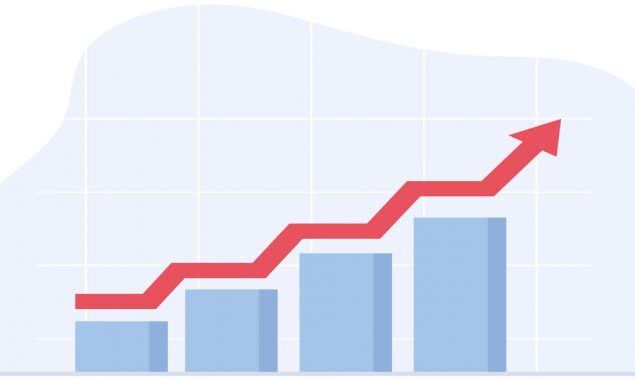Synopsis
Record headline inflation completely exhausted the economic revival

KARACHI: Despite improvement in business activities after complete lockdown, Pakistanis remain pessimistic about the fate of the country’s economy with a continuous hike in inflation, high key policy rates, and burgeoning import bill and twin deficits.
At the start of 2022, the world was optimistic that the development of pioneering vaccines would restrict the global spread of the Covid-19 and improve the financial situation but, in Pakistan, several other issues behave otherwise and the country falls prey to uncertain conditions.
It was December 2020 when the world marked the administration of vaccines for the Covid-19 patients but owing to the emergence of one after another viruses, the death toll tripled since then, according to the World Health Organisation.
The WHO and other health organisations have said that the vaccine will not end the pandemic but will help contain the spread and the global trade and financial activities would resume unhindered, which proved to be the case.
In Pakistan, after the Covid-19 pandemic, 2020 and early 2021 remained the toughest periods but gradually things get better and by the end of 2021, the businesses activities started returning to normalcy.
Unfortunately, the ill-conceived policies of the government make the lives of the common man miserable.
The sharp rise in the petroleum prices, spike in the natural gas prices and electricity tariff and a record headline or food inflation of around 28 per cent, completely exhausted the economic revival.
It seems that the price pressures will be more entrenched and would be the unwanted gift during 2022.
Senior economist and former chairman of the Federal Board of Revenue (FBR) Shabbar Zaidi said that Pakistan is the victim of financial corruption.
“However, the foundations of our economy has shaken due to intellectual corruption. Trade versus industry; Dubai model; cash economy; presumptive taxation; filthy forex system; perpetual immunity to whiten money, etc. Bigger crime as it destroyed,” he added.
Federation of Pakistan Chambers of Commerce and Industry (FPCCI) Businessmen Panel presidential candidate for the elections Irfan Iqbal Sheikh said that Pakistan is the most frequent customer of the International Monetary Fund.
“The governments often depend on borrowing from the lending arm and accepted stringent conditions, despite the fact that this institution is merciless money lender, which has always forced Pakistan to adopt bad policies like new taxes in the budget, the rupee depreciation and massive increases in the electricity and gas tariffs,” he added.
Pakistan’s capital market remained gloomy and uncertain, contrary to the global trend, where the economies endure the overall strength of the capital markets, despite the Covid-19 pandemic.
The impact of inflationary pressures and increasingly tighter monetary policy, as well as uncertainty around the Covid-19 pandemic will depress the economic conditions for the current fiscal year too.
The measures taken by the government and the State Bank of Pakistan (SBP) have signalled persistent elevated inflationary pressures, which will ultimately lead to higher interest rates in the times to come.
In its last monetary policy statement announced on November 19, 2021, the State Bank of Pakistan had hiked the key discount rate by around 150 basis points to 9.75 per cent, which leads to hike in inflation.
Pakistan’s headline or food inflation is currently running at a record 12.3 per cent. The external debt and liabilities increased $13 billion, or 11.4 per cent during the last one year.
The outstanding debt and liabilities of the country stood at $127 billion by September 2021, compared with $114 billion over the same period of the last year.
Similarly, the external public debt of the country increased $10.76 billion to $99.6 billion by the end of September 2021, compared with $88.9 billion a year ago.
Of the total public external debt, the government’s external debt increased to $80.95 billion, compared with $72.30 billion. The outstanding external debt from the International Monetary Fund (IMF) reduced to $7.07 billion as against $7.6 billion.
The outstanding external debt under the head of foreign exchange liabilities increased to $11.64 billion by September 2021, compared with $9.03 billion a year ago.
Likewise, the external debt of the public sector enterprises rose to $6.68 billion, compared with $5.13 billion. Foreign borrowing from the banks also registered an increase to $5.37 billion, compared with $4.41 billion.
The private sector foreign borrowing; however, slightly reduced to $11.09 billion by September 2021 as against $11.32 billion in the same period of the last year.
The SBP data also showed that the ratio of debt and liabilities to the GDP increased to 40.2 per cent by September 2021 as against 39.6 per cent a year ago.
The public external debt-to-GDP ratio also increased to 31.6 per cent, compared with 30.9 per cent a year ago.
The starker figures though, against the backdrop of tighter monetary policy, is the increase in the private debt. As interest rates climb, the debt defaults could increase next year, particularly as the rise in the Omicron variant cases have already forced the government to impose fresh restrictions on the economic activities.
Under the present circumstances, Pakistan’s economic recovery seems to be a daunting task for the government.
Read More News On
Catch all the Business News, Breaking News Event and Latest News Updates on The BOL News
Download The BOL News App to get the Daily News Update & Follow us on Google News.




